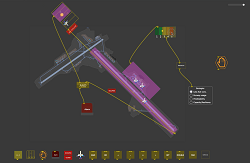User-centred system supports airport controllers in managing ground operations
Airports are complex places, especially when it comes to managing the movements of different classes of aircraft and a large number of service vehicles. Compounding factors, such as bad weather, place further burdens on airports’ traffic control, both from a human and technical perspective. Current automated systems have to cope with extremely dynamic environments. During the design stage, system developers can’t fully define the systems’ behaviour to handle all possible unusual situations. Funded within the framework of the SESAR Joint Undertaking, a public-private partnership set up to modernise Europe’s air traffic management system, the TaCo(opens in new window) project “took a fresh look at the challenge of complex surface operations, especially in non-standard conditions,” says project coordinator Dr Damiano Taurino. To accomplish this, the project explored automation in disciplines such as robotics and gaming. “TaCo defined an automated system able to support both ground and tower controllers’ tasks in airport operations and assess its own ability to deal with non-nominal conditions.” Tackling complexity TaCo elaborated a framework for an automated system to substantially reduce controllers’ tasks for each flight. This is sufficiently powerful to fully support the complex tasks involved in the management of surface movements at a complex airport. Project partners placed emphasis on providing the controller with suitable and usable tools to supervise the system. They also focused on enabling the system to self-assess its own ability to deal with non-nominal conditions: the system is sensitive enough to transfer responsibilities for traffic management back to the human when complexity goes beyond certain thresholds. This can be done in a timely and smooth manner, and also in a way that makes controllers comfortable with their inherited tasks. The project team applied a user-centred approach to the design and development of an airport automation environment. “This was a key enabler for successful involvement of end users in a process of incremental design, development and solution validation,” notes Dr Taurino. “Results of a final evaluation with end users generated positive feedback.” Humans and automation as a team Team members studied and introduced strategic teamwork between the human actors and automation. The aim was to manage the main performance indices of the airport, namely safety, predictability, capacity, and noise and CO2 reduction. They identified additional promising strategies during the assessment. These weren’t only designed as tools for performance optimisation, but also as ‘pre-sets’ to program automated behaviours in specific situations. Researchers identified potential future steps towards higher levels of technology readiness. These include advanced simulations with real traffic flows, and the scalability of the approach towards higher complexities and/or airport sizes. In addition, they further investigated integration with already existing airport ‘safety nets’. “The proposed TaCo solutions create a valuable benefit for ground operations, even in airports that aren’t so highly complex,” concludes Dr Taurino. “Despite the uniqueness of each airport, employing a support tool that helps controllers achieve and optimise the management of surface movements is a need that can be fulfilled by TaCo-like systems with no major changes to the concept.”







